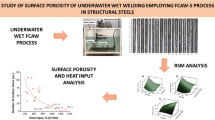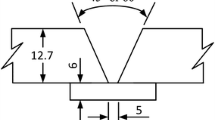Abstract
In recent years, the researches have been leaning towards the use of the wet welding process using the self-shielded flux-cored arc welding (FCAW-S) due to its higher productivity. Processing parameters such as welding current (I), arc voltage (E) and welding speed (v) notably determine the final microstructure and resulting mechanical properties of underwater wet welds. In this research work, the effect of the heat input generated by experimental underwater wet welding using the FCAW-S process on the microstructure and microhardness of weld beads made on ASTM A36 steel plates is investigated. For this purpose, experimental underwater welding tests were carried out in a special tank containing 30 cm of water column using three levels of heat input (578, 694 and 1074 J/mm) and a commercial filler metal (AWS E71T-GS). The microstructure and mechanical properties of the weld beads obtained were characterized by scanning electron microscopy (SEM) and Vickers hardness tests, respectively. In general, the experimental results show that the microstructure in both heat-affected zone (HAZ) and fusion zone (FZ) is basically constituted by martensite (M) for the three energy levels studied, which is related to the high cooling rates involved in the underwater welding processes. In addition, the mechanical properties reveal that the hardness values decrease with the increase in heat input due that increasing the ratio decreases the cooling rate and the martensite resulting is less hard. Finally, it is concluded that it is necessary to change the filler metal or looking for better parameters configuration to obtain higher heat input and change de microstructure in the fusion zone (FZ) to improve the mechanical properties in the welded component.
Graphical abstract




Similar content being viewed by others
Data availability
The datasets generated during and/or analyzed during the current study are available from the corresponding author on reasonable request.
References
J.H. Nixon, C.J. Allum, J.M. Lowes, Underwater welding: a review. Adv. Mater. Sci 3, 147–172 (1982). https://doi.org/10.2478/v10077-008-0040-3
N. Guo, Y. Du, J. Feng, W. Guo, Z. Deng, Study of underwater wet welding stability using an X-ray transmission method. J. Mater. Process. Technol. 225, 133–138 (2015). https://doi.org/10.1016/j.jmatprotec.2015.06.003
L.E. Ramírez Luna, A.Q. Bracarense, E.C.P. Pessoa, P.S. Costa, G. Altamirano Guerrero, A.E. Salas Reyes, Effect of the welding angle on the porosity of underwater wet welds performed in overhead position at different simulated depths. J. Mater. Process. Technol. 294, 117114 (2021). https://doi.org/10.1016/j.jmatprotec.2021.117114
ASM International, Handbook Committee. Welding, Brazing, and Soldering, vol. 6 (ASM International, Estados Unidos, 1993)
E. Surojo, E.D. Putri, E.P. Budiana, Recent developments on underwater welding of metallic material. Procedia Struct. Integr. 27, 14–21 (2020). https://doi.org/10.1016/j.prostr.2020.07.003
G.R.P. de Souza, J.R. de Barros, K.L. Cruz, M.M. de Carvalho, R.O. de Martins, R.F. de Souza et al., Análise do potencial uso do processo de soldagem FCAW-S na execução de fundações profundas. Unisanta Sci. Technol. 6, 17–26 (2017)
E.C.P. Pessoa, S. Liu, The state of the art of underwater wet welding practice: part 1. Weld. J. 100, 132–141 (2021). https://doi.org/10.29391/2021.100.011
E.D.W.S. Putri, E. Surojo, E.P. Budiana, Current research and recommended development on fatigue behavior of underwater welded steel. Procedia Struct. Integr. 27, 54–61 (2020). https://doi.org/10.1016/j.prostr.2020.07.008
J. Łabanowski, D. Fydrych, G. Rogalski, Underwater welding: a review. Adv. Mater. Sci. 8, 11–22 (2008). https://doi.org/10.2478/v10077-008-0040-3
N. Guo, Q. Cheng, Y. Fu, Y. Du, X. Zhang, J. Feng, Investigation on the mass transfer control, process stability and welding quality during underwater pulse current FCAW for Q235. J. Manuf. Process. 46, 317–327 (2019). https://doi.org/10.1016/j.jmapro.2019.08.022
Y. Shi, Z. Zheng, J. Huang, Sensitivity model for prediction of bead geometry in underwater wet flux cored arc welding. Trans. Nonferrous Met. Soc. China 23, 1977–1984 (2013). https://doi.org/10.1016/S1003-6326(13)62686-2
A.G. Oikonomou, G.A. Aggidis, Determination of optimum welding parameters for the welding execution of steels used in underwater marine systems (including the submerged parts of Wave Energy Converters). Mater. Today Proc. 18, 455–461 (2019). https://doi.org/10.1016/j.matpr.2019.06.211
Q. Yang, Y. Han, C. Jia, J. Wu, S. Dong, C. Wu, Impeding effect of bubbles on metal transfer in underwater wet FCAW. J. Manuf. Process. 45, 682–689 (2019). https://doi.org/10.1016/j.jmapro.2019.08.013
Y. Fu, N. Guoa, Y. Du, H. Chen, C. Xu, J. Fenga, Effect of metal transfer mode on spatter and arc stability in underwater flux-cored wire wet welding. J. Manuf. Process. 35, 161–168 (2018). https://doi.org/10.1016/j.jmapro.2018.07.027
C. Xu, N. Guo, X. Zhang, H. Chen, Y. Fu, L. Zhou, Internal characteristic of droplet and its influence on the underwater wet welding process stability. J. Mater. Process. Technol. 280, 1–10 (2020). https://doi.org/10.1016/j.jmatprotec.2020.116593
E.C.P. Pessoa, S. Liu, The state of the art of underwater wet welding practice: part 2. Weld. J. 100, 171–182 (2021). https://doi.org/10.29391/2021.100.014
Y. Suga, The effect of cooling rate on mechanical properties of underwater wet welds. Trans. Jpn. Weld. Soc. 21, 72–77 (1990). https://doi.org/10.2207/qjjws.5.358
Y. Hu, Y. Shi, K. Sun, X. Shen, Microstructure evolution and mechanical performance of underwater local dry welded DSS metals at various simulated water depths. J. Mater. Process. Technol. 264, 366–376 (2019). https://doi.org/10.1016/j.jmatprotec.2018.09.023
H. Chen, N. Guo, X. Zhang, Q. Cheng, L. Zhou, G. Wang, Effect of water flow on the microstructure, mechanical performance, and cracking susceptibility of underwater wet welded Q235 and E40 steel. J. Mater. Process. Technol. 277, 1–13 (2020). https://doi.org/10.1016/j.jmatprotec.2019.116435
J. Tomków, M. Landowski, D. Fydrych, G. Rogalski, Underwater wet welding of S1300 ultra-high strength steel. Mar. Struct. 81, 103120 (2022). https://doi.org/10.1016/j.marstruc.2021.103120
C. Xu, N. Guo, X. Zhang, H. Jiang, H. Chen, J. Feng, In situ X-ray imaging of melt pool dynamics in underwater arc welding. Mater. Des. 179, 107899 (2019). https://doi.org/10.1016/j.matdes.2019.107899
H. Chen, N. Guo, Z. Zhang, C. Liu, L. Zhou, G. Wang, A novel strategy for metal transfer controlling in underwater wet welding using ultrasonic-assisted method. Mater. Lett. 270, 127692 (2020). https://doi.org/10.1016/j.matlet.2020.127692
A.L.V. da Costa e Silva, P.R. Mei, Aços e ligas especiais, 3rd edn. (Blucher, São Paulo, 2010)
E. Surojo, E.D.W. Syah Putri, E.P. Budiana, Recent developments on underwater welding of metallic material. Procedia Struct. Integr. 27, 14–21 (2020)
Y. Zhang, C. Jia, B. Zhao, J. Hu, C. Wu, Heat input and metal transfer influences on the weld geometry and microstructure during underwater wet FCAW. J. Mater. Process. Technol. 238, 373–382 (2016). https://doi.org/10.1016/j.jmatprotec.2016.07.024
C. Xu, N. Guo, X. Zhang, H. Jiang, Y. Tan, L. Zhou, Influence of welding speed on weld pool dynamics and welding quality in underwater wet FCAW. J. Manuf. Process. 55, 381–388 (2020). https://doi.org/10.1016/j.jmapro.2020.03.046
F. Pérez-Guerrero, S. Liu, Explaining porosity formation in underwater wet welds. Proc. Int. Conf. Offshore Mech. Arct. Eng. 4, 249–257 (2007). https://doi.org/10.1115/OMAE2007-29696
Y. Shi, Y. Hu, Y. Yi, S. Lin, Z. Li, Porosity and microstructure of underwater wet FCAW of duplex stainless steel. Metallogr. Microstruct. Anal. 6, 383–389 (2017). https://doi.org/10.1007/s13632-017-0376-3
E. Surojo, A.H. Gumilang, T. Triyono, A.R. Prabowo, E.P. Budiana, N. Muhayat, Effect of water flow on underwater wet welded a36 steel. Metals (Basel) 11, 682 (2021). https://doi.org/10.3390/met11050682
C. Xu, N. Guo, X. Zhang, H. Jiang, H. Chen, J. Feng, In situ X-ray imaging of melt pool dynamics in underwater arc welding. Mater. Des. 179, 1–12 (2019)
Acknowledgments
We appreciate the financial support for this research from the Tecnológico Nacional de México and Consultores Asociados en Soldadura funds and the knowledge acquired. The author P Costa thanks CONACYT for their support in the form of postdoctoral fellowship
Author information
Authors and Affiliations
Corresponding author
Ethics declarations
Conflict of interest
The authors declare no competing interests.
Additional information
Publisher's Note
Springer Nature remains neutral with regard to jurisdictional claims in published maps and institutional affiliations.
Rights and permissions
Springer Nature or its licensor (e.g. a society or other partner) holds exclusive rights to this article under a publishing agreement with the author(s) or other rightsholder(s); author self-archiving of the accepted manuscript version of this article is solely governed by the terms of such publishing agreement and applicable law.
About this article
Cite this article
de Luna, I.F., Costa, P., Altamirano-Guerrero, G. et al. Effect of heat input on microstructure and mechanical properties in underwater wet flux-cored arc welding of structural steels. MRS Advances 7, 1049–1053 (2022). https://doi.org/10.1557/s43580-022-00410-3
Received:
Accepted:
Published:
Issue Date:
DOI: https://doi.org/10.1557/s43580-022-00410-3




